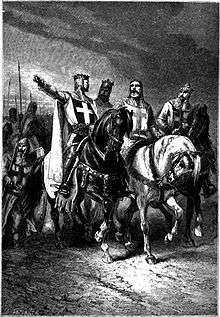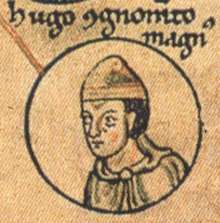Hugh, Count of Vermandois
| Hugh I of Vermandois | |
|---|---|
|
Hugh I of Vermandois | |
| Spouse(s) | Adelaide, Countess of Vermandois |
| Noble family | House of Capet |
| Father | Henry I of France |
| Mother | Anne of Kiev |
| Born | 1057 |
| Died |
18 October 1101 Tarsus |
| French Monarchy |
| Direct Capetians |
|---|
.svg.png) |
| Hugh Capet |
| Robert II |
| Henry I |
| Philip I |
| Louis VI |
| Louis VII |
| Philip II |
| Louis VIII |
| Louis IX |
| Philip III |
| Philip IV |
|
|
| Louis X |
| John I |
| Philip V |
| Charles IV |
|

Hugh (1057 – October 18, 1101),[1][2] called the Great (Latin Hugo Magnus), was a younger son of Henry I of France and Anne of Kiev and younger brother of Philip I.[3] He was Count of Vermandois in right of his wife (jure uxoris). His nickname Magnus (greater or elder) is probably a bad translation into Latin of a French nickname, le Maisné, meaning "the younger", referring to Hugh as younger brother of the King of France.[4]
Biography
In 1085 Hugh helped William the Conqueror repel a Danish invasion of England.[5]
Early 1096 Hugh and Philip began discussing the First Crusade after news of the Council of Clermont reached them in Paris.[6] Although Philip could not participate, as he had been excommunicated,[3] Hugh was said to have been influenced to join the Crusade after an eclipse of the moon on February 11, 1096.[7][8]
Late August 1096 Hugh and a small army left France and travelled via the Alps and Rome to Bari, where he would cross the Adriatic Sea into territory of the Byzantine Empire, unlike most crusaders who travelled over land.[9] His armada was possibly commanded by Arnout II, Count of Aarschot. According to Anna Comnena's chronicle the Alexiad Hugh sent an 'absurd' message to her father, Eastern Roman Emperor Alexius I Comnenus, demanding a proper welcome:
'Know, Emperor, that I am the King of Kings, the greatest of all beneath the heavens. It is fitting that I should be met on my arrival and received with the pomp and ceremony appropriate to my noble birth.'[10]
In response to this message the emperor sent 'urgent instructions' to his nephew John Komnenos, the Doux (governor) of Dyrrhachium and Nicholas Maurokatakalon, commander of the Byzantine fleet, to look out for Hugh and to inform him immediately when he arrived.[11]
Meanwhile Hugh had reached the coast of Longobardi and dispatched twenty-four envoys to the Doux of Dyrrhachium with the following message: 'Be it known to you, Doux, that our Lord Hugh is almost here. He brings with him from Rome the golden standard of St Peter. Understand, moreover, that he is supreme commander of the Frankish army. See to it then that he is accorded a reception worthy of his rank and yourself prepare to meet him.'[12] Whilst sailing the Adriatic Sea from Bari towards Illyricum, Hugh's fleet was overtaken by a heavy storm and most ships were lost. His own ship was thrown upon the shore near Epirus. When Hugh was found and brought to Dyrrhachium John Komnenos treated him to a banquet and he was allowed to rest. By order of the emperor Hugh was closely escorted by Manuel Boutoumites. Eventually Hugh was given an audience by the emperor, who persuaded him to become his liegeman.[13][14]
The German historian Hans Eberhard Mayer argued that Alexius was fortunate that the first contingent of the crusader army to arrive in Constantinople, led by Hugh, was very small and easy to control. Alexius 'discreetly but unmistakably' restricted Hugh's freedom of movement 'until he was ready to swear that all territories which had belonged to Byzantium before the Turkish invasions would be restored. Moreover any conquests made to the east [...] would be held as fiefs.'[15]
Anna Comnena recorded a conversation between Hugh and Godfrey of Bouillon, wherein Hugh tried to persuade Godfrey to pledge allegiance to Alexius. Godfrey however refused, saying: 'you left your own country as a ruler [...] with all that wealth and a strong army; now from the heights you've brought yourself to the level of a slave. And then, as if you had won some great success, have you come here to tell me to do the same?' Hugh replied: 'we ought to have stayed in our own countries and kept our hands off other people's [...] but since we've come thus far and need the emperor's protection, no good will come of it unless we obey his orders.'[16]
After the Crusaders had successfully made their way across Seljuk territory and, in 1098, captured Antioch, Hugh was sent back to Constantinople to appeal for reinforcements from Alexius. The emperor was uninterested,[17] however, and Hugh, instead of returning to Antioch to help plan the siege of Jerusalem, went back to France. There he was scorned for not having fulfilled his vow as a Crusader to complete a pilgrimage to Jerusalem, and Pope Paschal II threatened to excommunicate him. He joined the minor Crusade of 1101, but was wounded in battle with the Turks in September, and died of his wounds in October in Tarsus.
Family and children
He married Adelaide of Vermandois,[18] the daughter of Herbert IV, Count of Vermandois and Adele of Valois. They had nine children:
- Mathilde, married Raoul I of Beaugency[18]
- Elizabeth of Vermandois, Countess of Leicester (d. 1131)
- Beatrice (fl. 1144), married Hugh IV of Gournay
- Ralph I (d. 1152)
- Constance (date of death unknown), married Godfrey de la Ferté-Gaucher
- Agnes (living 1125), married Boniface del Vasto
- Henry (d 1130), seigneur of Chaumont en Vexin
- Simon (d 1148)
- William (d.c. 1096)
Ancestry
| Ancestors of Hugh, Count of Vermandois | |||||||||||||||||||||||||||||||||||||||||||||||||||||||||||||||||||||||||||||||||||||||||||||||||||||||||||||||||||||||||||||||||||||||||||||||||||||||||||||||||||||||||||||||||||||||||||||||||||||||||||||||||||||||||||||||||||||||||||||||||||||||||||||||||||||||||||||||||||||||||||||||||||||||||||||||||||||||||||||||||||||||||||||||||||||||||||||||||||||||||||||||||||||||||||||||||||||||||||||||||||||||||||||||||||||||||||||||||||||||||||||||||||||||||||||||||||||||||||||||||
|---|---|---|---|---|---|---|---|---|---|---|---|---|---|---|---|---|---|---|---|---|---|---|---|---|---|---|---|---|---|---|---|---|---|---|---|---|---|---|---|---|---|---|---|---|---|---|---|---|---|---|---|---|---|---|---|---|---|---|---|---|---|---|---|---|---|---|---|---|---|---|---|---|---|---|---|---|---|---|---|---|---|---|---|---|---|---|---|---|---|---|---|---|---|---|---|---|---|---|---|---|---|---|---|---|---|---|---|---|---|---|---|---|---|---|---|---|---|---|---|---|---|---|---|---|---|---|---|---|---|---|---|---|---|---|---|---|---|---|---|---|---|---|---|---|---|---|---|---|---|---|---|---|---|---|---|---|---|---|---|---|---|---|---|---|---|---|---|---|---|---|---|---|---|---|---|---|---|---|---|---|---|---|---|---|---|---|---|---|---|---|---|---|---|---|---|---|---|---|---|---|---|---|---|---|---|---|---|---|---|---|---|---|---|---|---|---|---|---|---|---|---|---|---|---|---|---|---|---|---|---|---|---|---|---|---|---|---|---|---|---|---|---|---|---|---|---|---|---|---|---|---|---|---|---|---|---|---|---|---|---|---|---|---|---|---|---|---|---|---|---|---|---|---|---|---|---|---|---|---|---|---|---|---|---|---|---|---|---|---|---|---|---|---|---|---|---|---|---|---|---|---|---|---|---|---|---|---|---|---|---|---|---|---|---|---|---|---|---|---|---|---|---|---|---|---|---|---|---|---|---|---|---|---|---|---|---|---|---|---|---|---|---|---|---|---|---|---|---|---|---|---|---|---|---|---|---|---|---|---|---|---|---|---|---|---|---|---|---|---|---|---|---|---|---|---|---|---|---|---|---|---|---|---|---|---|---|---|---|---|---|---|---|---|---|---|---|---|---|---|---|---|---|---|---|---|---|---|---|---|---|---|---|---|---|---|---|---|---|---|---|---|---|---|---|---|---|---|---|---|---|---|---|---|---|---|---|---|---|---|---|---|---|---|---|---|---|---|---|---|---|---|---|---|---|---|---|---|---|---|---|---|---|---|---|---|---|---|---|---|---|---|---|---|---|---|---|---|---|---|---|---|
| |||||||||||||||||||||||||||||||||||||||||||||||||||||||||||||||||||||||||||||||||||||||||||||||||||||||||||||||||||||||||||||||||||||||||||||||||||||||||||||||||||||||||||||||||||||||||||||||||||||||||||||||||||||||||||||||||||||||||||||||||||||||||||||||||||||||||||||||||||||||||||||||||||||||||||||||||||||||||||||||||||||||||||||||||||||||||||||||||||||||||||||||||||||||||||||||||||||||||||||||||||||||||||||||||||||||||||||||||||||||||||||||||||||||||||||||||||||||||||||||||
Sources
- Peters, Edward, ed. (1971). The First Crusade. Philadelphia: University of Pennsylvania Press. ISBN 0812210174.
- Riley-Smith, Jonathan, The First Crusaders, 1095-1131, Cambridge University Press, Cambridge, 1997
- Bury, J. B. (Editor), The Cambridge Medieval History, Volume V: Contest of Empire and Papacy, Cambridge at the University Press, Cambridge, 1926
References
- ↑ Guibert of Nogent, Dei gesta per Francos 7.23, R.B.C. Huygens ed., CC CM 127A (Turnhout 1996), 313.
- ↑ Fulcheri Carnotensis, Historia Hierosolymitana, Liber II, XVI, 7, H. Hagenmeyer ed. (Heidelberg 1913), 433n.
- 1 2 Peters 1971, p. 35.
- ↑ Cf. Steven Runciman; Rosalind Hill traces the error to the anonymous Gesta Francorum, and explains it as a confusion with the old French "maisné" (younger brother) (R. Hill and R. A. B. Mynors (eds), 'Gesta Francorum et aliorum Hierosolimitanorum, 1962, London, xi-xii).
- ↑ Christopher Tyerman, How to Plan a Crusade. Reason and Religious War in the High Middle Ages (London 2015), 134.
- ↑ Jean Flori, Pierre L'Ermite et la Première Croisade (Paris 1999), 232.
- ↑ Jean Flori, Pierre L'Ermite et la Première Croisade (Paris 1999), 232.
- ↑ Thomas Asbridge, The First Crusade, a new history. The roots of conflict between Christianity and Islam (New York 2004), 56.
- ↑ Thomas Asbridge, The First Crusade, a new history. The roots of conflict between Christianity and Islam (New York 2004), 92.
- ↑ Anna Komnene, The Alexiad, E.R.A. Sewter and Peter Frankopan eds. (London 2009), 279.
- ↑ Anna Komnene, The Alexiad, E.R.A. Sewter and Peter Frankopan eds. (London 2009), 279.
- ↑ Anna Komnene, The Alexiad, E.R.A. Sewter and Peter Frankopan eds. (London 2009), 280.
- ↑ Anna Komnene, The Alexiad, E.R.A. Sewter and Peter Frankopan eds. (London 2009), 280-281.
- ↑ Peter Frankopan, The First Crusade. The call from the east (Cambridge, Massachusetts 2012), 124-125.
- ↑ Hans Eberhard Mayer, The Crusades, translated by John Gillingham (Oxford 1972), 48.
- ↑ Anna Komnene, The Alexiad, E.R.A. Sewter and Peter Frankopan eds. (London 2009), 288.
- ↑ In "Urban's Crusade--Success or Failure" (Key, 1948) it is argued, indeed to the contrary, that the emperor was disturbed by Hugh's report and the disquieting rumors emitting from Antioch (on Bohemond's intent and conduct) and promptly set out to prepare another expedition: "...Alexius immediately began preparations for another expedition, and he furthermore sent envoys to the crusaders to announce its coming."
- 1 2 Suger, The Deeds of Louis the Fat, transl. Richard C. Cusimano and John Moorhead, (Catholic University of America Press, 1992), 191-192 note19.
| Hugh, Count of Vermandois Born: 1057 Died: 18 October 1101 | ||
| French nobility | ||
|---|---|---|
| Preceded by Odo |
Count of Vermandois with Adelaide 1085–1101 |
Succeeded by Ralph I |
